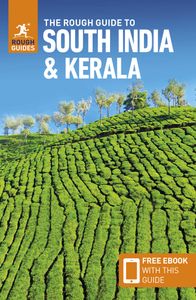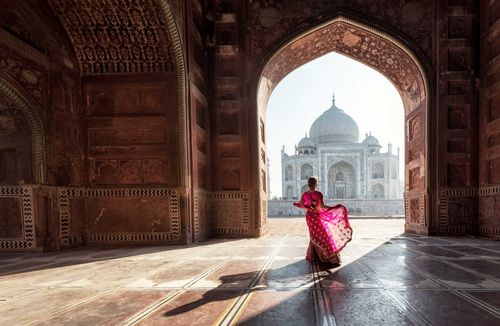For vegetarians, in particular, Indian food is a complete delight. Some of the Subcontinent’s best food is meat-free, and even confirmed carnivores will find themselves tucking into delicious dhals and vegetable curries with relish. Most religious Hindus, and the majority of people in the south, don’t eat meat or fish, while some orthodox Brahmins and Jains also avoid onions and garlic, which are thought to inflame the baser instincts. Veganism is not common, however; if you’re vegan, you’ll have to keep your eyes open for eggs and dairy products. Many eating places state whether they are vegetarian or non-vegetarian either on signs outside or at the top of the menu. The terms used in India (and throughout our eating listings) are “veg” and “non-veg”. You’ll also see “pure veg”, which means that no eggs or alcohol are served. As a rule, meat-eaters should exercise caution in India: even when meat is available, especially in the larger towns, its quality can be poor, except in the best restaurants, and you won’t get much in a dish anyway – especially in cheaper canteens where it’s mainly there for flavouring. Hindus, of course, do not eat beef and Muslims shun pork, so you’ll only find those in a few Christian enclaves such as the beach areas of Goa, and Tibetan areas. Note that what is called “mutton” on menus is in fact goat.
Where to eat
Broadly speaking, eating establishments divide into three main types: cheap and unpretentious local cafés (known variously as dhabas, bhojanalayas and udupis); Indian restaurants aimed at more affluent locals; and tourist restaurants. Dhabas and bhojanalayas are cheap cafés, where food is basic but often good, consisting of vegetable curry, dhal (a kind of lentil broth), rice or Indian bread (the latter more standard in the north) and sometimes meat. Often found along the sides of highways, dhabas traditionally cater to truck drivers – one way of telling a good dhaba is to judge from the number of trucks parked outside. Bhojanalayas are basic eating places, usually found in towns (especially around bus stands and train stations) in the north and centre of the country; they tend to be vegetarian, especially those signed as “Vaishno”. Both dhabas and bhojanalayas can be grubby – look them over before you commit yourself. The same is rarely true of their southern equivalent, udupi canteens, which offer cheap, delicious snacks such as masala dosa, idli, vada and rice-based dishes, all freshly cooked to order and served by uniformed waiters.
There are all sorts of Indian restaurants, veg and non-veg and typically catering to Indian businessmen and middle-class families. These are the places to go for reliably good Indian food at bargain prices. The more expensive Indian restaurants, such as those in five-star hotels, can be very expensive by local standards, but offer a rare chance to try top-notch classic Indian cooking, and still at significantly cheaper prices than you’d pay back home – assuming you could find Indian food that good.
Tourist restaurants, found across India wherever there are significant numbers of Western visitors, cater specifically for foreign travellers with unadventurous taste buds, serving up a stereotypical array of pancakes, omelettes, chips, muesli and fruit salad, along with a basic range of curries. The downside is that they tend to be relatively pricey, while the food can be very hit and miss – Indian spaghetti bolognese, enchiladas and chicken chow mein can be every bit as weird as you might expect. International-style fast food, including burgers (without beef – usually chicken or mutton) and pizzas, is also available in major cities.
Indian food
The basic distinction in Indian food is between the cuisines of the north and south. North Indian food (which is the style generally found in Indian restaurants abroad) is characterized by its rich meat and vegetable dishes in thick tomato, onion and yogurt-based sauces, accompanied by thick breads. South Indian food, by contrast, is largely vegetarian, with spicy chilli and coconut flavours and lots of rice, either served in its natural state or made into one of the south’s distinctive range of pancakes, such as the dosa, idli and uttapam, although coastal areas serve plenty of fish dishes.
What Westerners call a “curry” covers a huge variety of dishes, each made with a different masala, or mix of spices. Commonly used spices include chilli, turmeric, garlic, ginger, cinnamon, cardamom, cloves, coriander – both leaf and seed – cumin and saffron. Garam masala (“hot mix”) is a combination of spices often added to a dish at the last stage of cooking to spice it up.
Chilli is another key element in the Indian spice cabinet but the idea that all Indian food is fiery hot is a complete myth. North Indian food, in particular, tends to be quite mildly spiced, often more so than Indian food in restaurants abroad. South Indian food can be hotter but not invariably so. If you can’t take the heat, there are mild dishes such as korma and biryani where meat or vegetables are cooked with rice. Indians tend to assuage the effects of chilli with chutney, dahi (curd) or raita (curd with mint and cucumber, or other herbs and vegetables). Otherwise, beer is one of the best things for washing chilli out of your mouth; the essential oils that cause the burning sensation dissolve in alcohol, but not in water.
Vegetarian curries are usually identified (even on menus in English) by the Hindi names of their main ingredients, such as paneer (cheese), alu (potatoes), chana (chickpeas) or mutter (peas). Meat curries are more often given specific names such as korma or dopiaza, to indicate the kind of masala used or the method of cooking.
North Indian food
North Indian cooking has been heavily influenced by the various Muslim invaders who arrived in the Subcontinent from Central Asia and Persia. They gave Indian cooking many of its most popular dishes and accompaniments, such as the biryani and the naan bread, as well as its relatively greater emphasis on meat compared to the south. The classic north Indian fusion of native and Central Asian influences (although it can be found as far south as Hyderabad) is so-called Mughlai cooking, the creation of the Mughal dynasty. Mostly non-veg, the food is mildly spiced but extremely rich, using ingredients such as cream, almonds, sultanas and saffron – the classic korma sauce is the best-known example.
The other big northern style is tandoori. The name refers to the deep clay oven (tandoor) in which the food is cooked. Tandoori chicken is marinated in yogurt, herbs and spices before cooking. Boneless pieces of meat, marinated and cooked in the same way are known as tikka; they may be served in a medium-strength masala (tikka masala), one thickened with almonds (pasanda), or in a rich butter sauce (murg makhani or butter chicken). Breads such as naan and roti are also baked in the tandoor.
A main dish – which may be a curry, but could also be a dry dish such as a kebab, or a tandoori dish without a masala – is usually served with a dhal and bread. Rice is usually an optional extra in north India and has to be ordered separately.
Bread, which comes in a number of varieties, all of them flatbreads rather than loaves. Chapatti is a generic term for breads, but tends to refer to the simplest, unleavened type. It’s usually made from wheat flour. The term roti is likewise generic, and a roti can be exactly the same as a chapatti, but the term tends to refer more to a thicker bread baked in a tandoor. In good Muslim cooking, delicately thin rumali roti (“handkerchief” bread) often accompanies rich meat and chicken dishes. Naan is leavened, thick and chewy, and invariably baked in a tandoor; it’s a favourite in non-veg restaurants as it best accompanies rich meaty dishes. You may also come across fried breads, of which paratha (or parantha) is rolled out, basted with ghee, folded over and rolled out again several times before cooking, and often stuffed with ingredients such as potato (alu paratha); it’s popular for breakfast. Puris are little fried puffballs. Poppadum (papad) is a crisp wafer made from lentil flour and is typically served as an appetizer.
Many restaurants also offer set meals, or thalis. A thali is a stainless-steel tray with a number of little dishes in it, containing a selection of curries, a chutney and a sweet. In the middle you’ll get bread and usually rice. In many places, waiters will keep coming round with refills until you’ve had enough.
There’s an enormous variety of regional cuisines across the north. Bengalis love fish and cook a mean mangsho (meat) curry as well as exotic vegetable dishes such as mo-cha – cooked banana flower. They also like to include fish bones for added flavour in their vegetable curries – a nasty surprise for vegetarians. Tibetans and Bhotias from the Himalayas have a simple diet of thukpa (meat soup) and momo (meat dumplings), as well as a salty tea made with either rancid yak butter (where available) or with ordinary butter. In Punjab and much of northern India, home cooking consists of dhal and vegetables along with roti and less rice than the Bengalis. Food in Gujarat, predominantly veg, is often cooked with a bit of sugar. Certain combinations are traditional and seasonally repeated, such as makki ki roti (fried corn bread) with sarson ka sag (mustard-leaf greens) around Punjab and other parts of north India. Baingan bharta (puréed roast aubergine) is commonly eaten with plain yogurt and roti.
South Indian food
The food of south India is a world away from that of the north. Southern cooking also tends to use a significantly different repertoire of spices, with sharper, simpler flavours featuring coconut, tamarind, curry leaves and plenty of dried red and fresh green chillies. Rice is king, not only eaten in its natural form, but also made into regional staples such as idlis (steamed rice cakes), idiyyapams (steamed rice-noodle cakes) and dosas (fermented rice-batter pancakes), such as the ubiquitous masala dosa, a potato curry wrapped in a crispy lentil-flour pancake. An alternative to the dosa is the uttapam, which is thicker, often with onions or another vegetable fried into its body. The lavish breads that are such a feature of north Indian cooking aren’t usually available, apart from the fluffy little puri. Meat is comparatively uncommon in the brahmin-dominated temple towns of Tamil Nadu, but available throughout Kerala, where there are sizeable Christian and Muslim minorities.
Set meals are another common feature in the south, where they are generally referred to simply as “meals”. They generally consist of a mound of rice surrounded by various vegetable curries, sambhar dhal, chutney and curd, and usually accompanied by puris and rasam, a thin, hot, peppery soup. Traditionally served on a round metal tray or thali (also found in north India), with each side dish in a separate metal bowl, set meals are sometimes presesnted on a section of banana leaf instead. In most traditional restaurants, you can eat as much as you want, and staff circulate with refills of everything. In the south even more than elsewhere, eating with your fingers is de rigueur and cutlery may be unavailable in cheap restaurants.
Wherever you eat, remember to use only your right hand, and wash your hands before you start. Try to avoid getting food on the palm of your hand by eating with the tips of your fingers.














